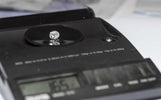
Diamond Carat Guide: Understanding Size, Weight, and Value
, by Michael Kerkinni, 2 min reading time

, by Michael Kerkinni, 2 min reading time
Diamond carat weight affects a diamond's size and price, but bigger isn’t always better. Learn how carat influences appearance and value, and find the perfect balance for your budget.
When shopping for a diamond, carat weight is often the first thing people consider. However, while carat affects a diamond’s size and price, it’s not the only factor that determines its beauty. Understanding carat weight, its impact on appearance, and how it interacts with the other 4Cs—Cut, Color, and Clarity—can help you make an informed decision.
Carat is a unit of measurement that defines a diamond’s weight. One carat equals 200 milligrams, and each carat is further divided into 100 points. For example, a 0.50-carat diamond is also referred to as a 50-point diamond.
Many people assume that a higher carat weight means a larger diamond, but that’s not always true. The perceived size of a diamond depends on its cut and shape:
Round Brilliant Diamonds maximize sparkle and can appear larger due to their faceting.
Oval, Pear, and Marquise Diamonds often look bigger than their carat weight suggests because of their elongated shapes.
Princess and Cushion Cuts may appear slightly smaller since more of their weight is held in their depth.
Carat weight significantly impacts a diamond’s price, as larger diamonds are rarer. However, price doesn’t increase linearly with size—it jumps at “magic weights” like 0.50, 1.00, 1.50, and 2.00 carats. Choosing a diamond just under these thresholds (e.g., 0.90 instead of 1.00 carat) can offer significant savings while maintaining a similar look.
When selecting a diamond, consider these tips:
Prioritize Cut: A well-cut diamond with a lower carat weight will look more brilliant than a larger, poorly cut stone.
Choose a Shape That Maximizes Size: Oval, pear, and marquise shapes appear larger per carat than round diamonds.
Consider Finger Size: A 1.00-carat diamond may look large on a petite finger but smaller on a larger hand.
Balance the 4Cs: A slightly lower carat weight with excellent cut and clarity can be a smarter investment than a bigger diamond with visible flaws.
Here are some common carat weight choices for engagement rings:
0.50 - 0.75 Carat: A great balance of size and affordability.
1.00 Carat: The classic choice with strong visual impact.
1.50 - 2.00 Carats: Ideal for those seeking a bold, eye-catching ring.
2.50 Carats and Up: Luxurious and rare, making a statement.
At Princess Jewelry, we offer a wide selection of lab-grown diamonds and naturally mined diamonds in all carat weights to suit every style and budget. Explore our collection today and find the perfect diamond for your dream ring!